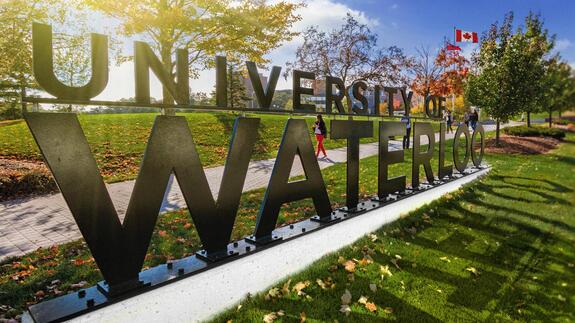
Waterloo and NRC reaffirm partnership on future-facing technology
The National Research Council’s continued support for AI, IoT and cybersecurity will help position Canada as a global leader

The National Research Council’s continued support for AI, IoT and cybersecurity will help position Canada as a global leader
By Sam Toman University Relations
Terry Stewart
NRC Associate Research Officer
> One of the researchers behind Spaun, the first biologically realistic brain simulation that can perform multiple tasks
If it makes you feel any better robots get old too.
Just like humans their joints begin to fail, and certain abilities fade or become less reliable over time. The difference (besides complaining about it) is humans naturally adjust or adapt their movement to compensate for decline.
“Figuring out how our brains process declining movement involves an incredible amount of computer simulations,” says, Terry Stewart an NRC Associate Research Officer at Waterloo. “These simulations have helped us create a biological representation of how the human brain might manage decline and given us a pathway to apply that to intelligent machines.”
Stewart and his team hope that this knowledge, combined with machine learning, can provide Canadian manufacturing with tremendous benefits and efficiencies.
“Let’s say a robot in a manufacturing plant performs the same function many thousands of times a day. Regular wear and tear can lead to that machine making mistakes. Even if it’s just a millimetre or two off, that can compromise its work.” says Stewart. “But if it can understand and predict that decomposition as it’s happening it can modify its motion.”
That project is just one of a host of NRC-sponsored projects underway at Waterloo making breakthroughs in artificial intelligence, the internet of things and cybersecurity.
Those projects include:
Automated Material Synthesis using Deep Reinforcement Learning
o Isaac Tamblyn (NRC)
o Mark Crowley (UW)
Battery-free Touch Sensors for Internet of Things
o Keiko Katsuragawa (NRC)
o Peng Hu (NRC)
o Omid Abari (UCLA)
o Daniel Vogel (UW)
Reliable Gesture Recognition in Virtual Reality Environment
o Keiko Katsuragawa (NRC)
o Ed Lank (UW)
Neuromorphics for Vision-Based Movement Planning and Control
o Chris Eliasmith (UW)
o Terry Stewart (NRC)
A Secure Scalable Quantum-Safe Blockchain for Critical Infrastructure
o Koray Karabina (NRC)
o Srinivasan Keshav (Cambridge)
o Michele Mosca (UW)

This second round of funding was reaffirmed by NRC President Iain Stewart as NRC and Waterloo come together on the development of five new upcoming projects, with Waterloo supplying matching funds bringing the total dollar amount to $900k. Those new projects will be decided on and announced March 31st.
The NRC and Waterloo Collaboration will help position Canada as a global leader in these future-relevant areas and aid the NRC is its mandate to increase its collaboration with regional ecosystems like the one that exists in the Region of Waterloo and universities like Waterloo.
“The work being done thanks to the generosity of NRC is going to keep Canada at the top of the pile of universities on the cutting edge of technological research,” says Terry Stewart. “Advancements being made in our labs today will hopefully soon be deployed in Canadian Plants, homes and infrastructure to make our society more innovative and resilient.

Read more
Computer scientists are moving us from tap and touch to gestures when it comes to controlling your smart phone

Read more
The collaboration will build on the relationship between Waterloo and the National Research Council at a new facility in Mississauga that was officially inaugurated on November 16.

Read more
University of Waterloo will play important role with applied AI solutions for everything from healthcare to finance and transportation
The University of Waterloo acknowledges that much of our work takes place on the traditional territory of the Neutral, Anishinaabeg, and Haudenosaunee peoples. Our main campus is situated on the Haldimand Tract, the land granted to the Six Nations that includes six miles on each side of the Grand River. Our active work toward reconciliation takes place across our campuses through research, learning, teaching, and community building, and is co-ordinated within the Office of Indigenous Relations.